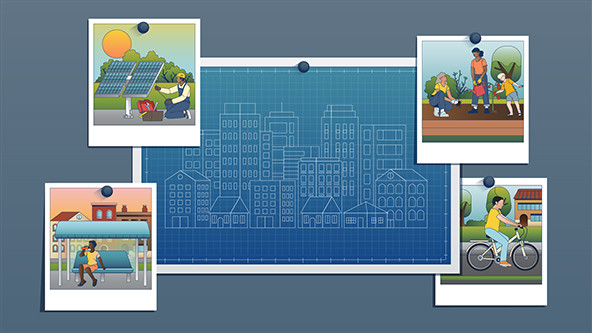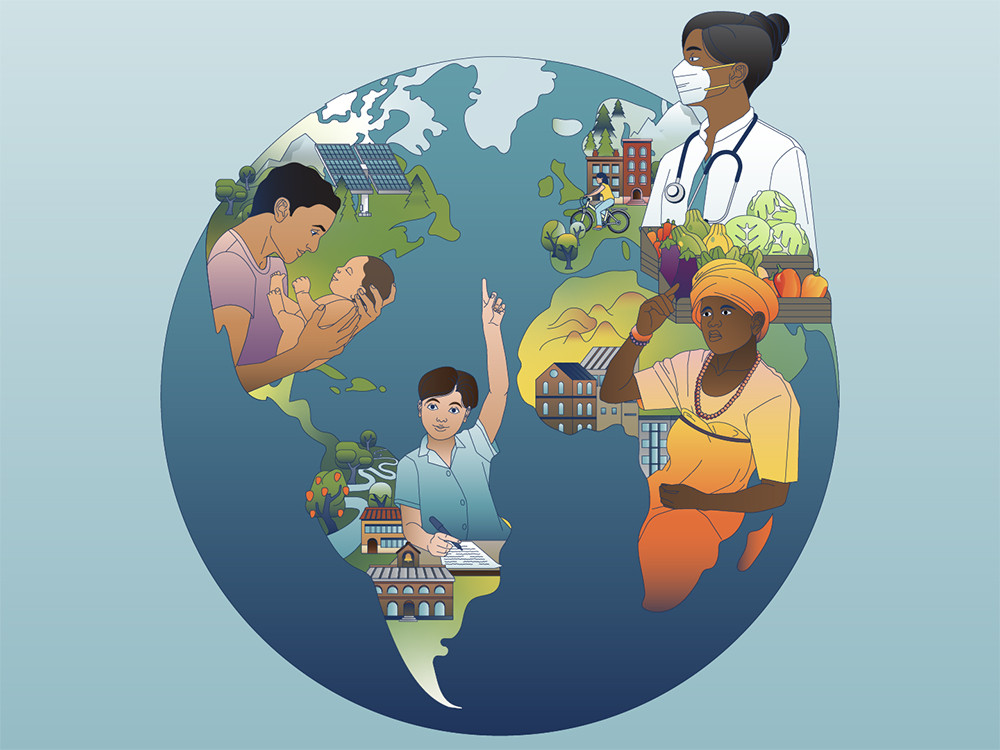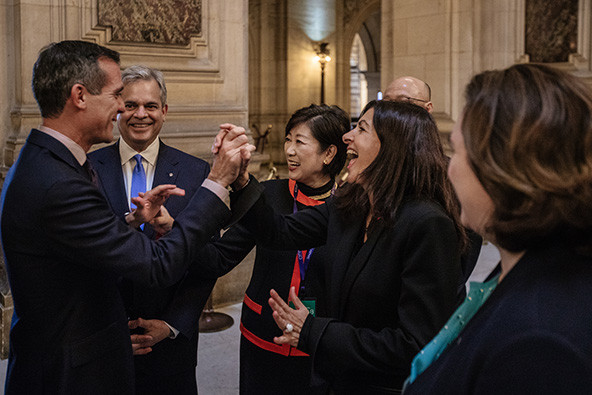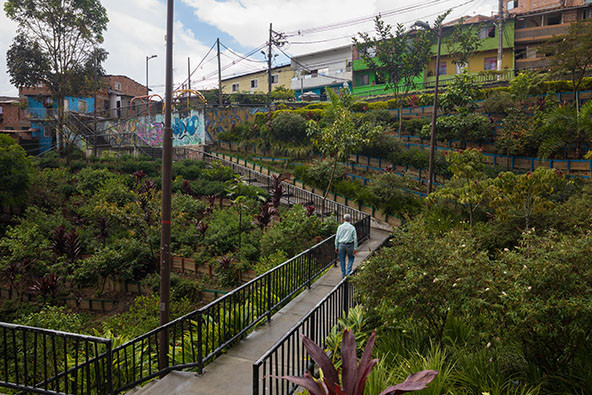 (Illustration courtesy of the Robert Wood Johnson Foundation)
(Illustration courtesy of the Robert Wood Johnson Foundation)
In July, the world saw the hottest day on record, and cities and towns around the world stepped up to the task of keeping their residents safe. While a single record-setting day is caused by many factors, including climate change and the El Niño phenomenon in the Pacific, it reflects the very real challenges cities are facing. Heat is currently killing more people than any other climate-related hazard. It also has an adverse impact on workforce productivity and inflicts economic losses on workers whose health and working conditions are affected by extreme heat.
Over the last decade, growing research on spatial justice—whether different communities have equitable access to resources and infrastructure that improve quality of life—has highlighted how differences between city neighborhoods affect all kinds of life outcomes. Where you live and work matters. It dictates whether your days and nights get hotter and what protective factors, such as accessible greenspace and tree canopy, you have access to when the temperature rises. And it´s not happenstance who lives in these communities; it’s often the result of structural racism and economic forces like gentrification and displacement that drives those with fewer resources into places with less social and physical infrastructure to support better health. In addition, children, the elderly, informal dwellers and other marginalized communities are more vulnerable to the effects of extreme heat than others.

While the headlines can be daunting, the good news is that many city leaders understand these issues and are using economic development, climate policy, health policy, transportation, and infrastructure to improve health, address climate change, and advance socio-economic justice in their communities. For example, in 2021 several cities, including Athens, Miami, and Dhaka, appointed their first ever “Chief Heat Officer,” a role created to respond directly to the severity and scale of climate challenges.
Mayors and city governments are increasingly seen as “doers” rather than “delayers” because they find themselves on the front line of the climate crisis. That is, in part, because leaders are closer to the community and there is baked-in accountability at the local level; failure to act can lead to being voted out. And at a time when many wish for more ambitious and faster global action on climate, perhaps we can find solace by looking a little closer to home in our cities for results.
In short, as the climate changes, cities are prime locations for experimentation, and with increasing frequency, city leaders are looking to each other for ideas, lessons, and inspiration.
Necessary Collaboration in the Face of Global Challenges
The fact that cities shouldn’t go at it alone became especially clear during the COVID-19 pandemic. At C40 Cities, a global network of approximately 100 megacities on a mission to tackle climate change, the pandemic shed light on the power of collective action and platforms that facilitate rapid shared learning. Mayors in the C40 Cities network pivoted, and with a newfound urgency, these city leaders collaborated on all manner of solutions, from making public transportation safe and accessible, to supporting and lifting up essential workers (in particular informal workers and traders) and implementing innovative approaches to coordinated food distribution. Once again, we were reminded that cities are well-equipped to learn, cooperate, and collaborate in the face of big global challenges.
The same is true when it comes to climate action. For example, despite the anti-environmental agenda of Jair Bolsonaro, the previous president of Brazil, some of the country’s largest cities, including São Paulo, Rio de Janeiro, Salvador, and Curitiba, came together to develop ambitious climate action plans in line with the Paris Agreement, and those plans are already underway. Rafael Greca, the mayor of Curitiba, officially launched the city’s Solar Pyramid earlier this year—the first solar plant to be built on a former landfill in Latin America—paired with investments in solar panels on buildings throughout the city. Curitiba has gained critical insight into how best to scale the project’s successes, with around 2,600 public buildings throughout the city deemed appropriate sites for a similar photovoltaic cells (PV) solar project. Carbon reductions from the Solar Pyramid will equate to taking more than 20,000 cars off the road for a year, together with more than US$500,000 in yearly savings.
 Eric Garcetti (far left), former mayor of Los Angeles, greets Anne Hidalgo (second from right), mayor of Paris. (Photo by Sarah Bastin/C40 Cities)
Eric Garcetti (far left), former mayor of Los Angeles, greets Anne Hidalgo (second from right), mayor of Paris. (Photo by Sarah Bastin/C40 Cities)
Key to the success of any similar project is close collaboration between different government departments from the project’s inception, adopting a holistic approach with internal and external stakeholders, identifying relevant environmental and tax laws, land rights, and finding strong financial partners to secure suitable and sustainable financing.
The results reach far beyond Curitiba. Other cities have been inspired by the Solar Pyramid project. This July, Rio de Janeiro signed a public-private partnership with Consortium Rio Solar to implement the Carioca Solarium project. In the next 12 months, a retired landfill site in Santa Cruz, to the west of the city, will be equipped with 11,000 panels, providing clean energy for 45 schools and 15 emergency care units, and lead to at least half a million dollars in energy savings annually. Interest in this model has spread to Mumbai, Cape Town, Dakar, Jakarta, and Kuala Lumpur.
Lessons for City Leaders Around the World
What we see in Brazil is just one of hundreds of examples of coordination and global learning. Getting under the skin of these collaborations and exchanges is key. In my role at C40 and my work with other city networks, I often sit at the crossroads of many of these city-to-city collaborations and have observed three lessons that can help city leaders accelerate learning and take action.
- Good ideas can’t always be replicated exactly, but they can be adapted and inspire others. Many solutions reduce emissions and improve air quality, such as developing cycling infrastructure or bus rapid transit (BRT) systems, that largely can be picked up and replicated by any city. However, for more complex efforts and initiatives, the most valuable lesson can come from sharing strategies to build support and tailor a solution for a given city. For example, the movement in Barcelona to shut off some residential streets to through traffic to create “superblocks” has helped to spawn a range of similar projects.
 A community garden in Medellín, Colombia. (Photo by Ivan Valencia/C40 Cities)
A community garden in Medellín, Colombia. (Photo by Ivan Valencia/C40 Cities)
Architect Salvador Rueda first proposed the concept of superblocks in 1987, and in Barcelona’s 2013-18 Urban Mobility Plan, the city introduced “superilles,” also known as superblocks. This government-funded project created an island of walking, green, and quiet space and gave streets back to people (without claiming extra land) by essentially turning several smaller blocks into one larger block. The goal was to reduce traffic pollution and prioritize healthy and sustainable mobility, but it was an audacious move to create nine-block grids that turned what were once car-centric streets into public spaces for socializing, walking, and cycling.
Cities seeking to implement similar projects often face pushback rooted in concerns about how they will affect small businesses or potentially gentrify neighborhoods. The lesson from Barcelona is that by focusing on spatial justice and deep community engagement, city councils can prioritize low-income neighborhoods to actively address inequities in health outcomes or access to green space. After several successful pilots and a careful analysis of project impacts after implementation, Barcelona plans to install 503 superblocks across the city by 2030. And today, more than 250 cities, including Berlin, Bogotá, and Los Angeles, have set out to learn more about how superblocks work. Cities are not just learning technological innovations from each other, but increasingly social innovations that are critical to radical transformation.
- Without conscious intent, climate action can deepen inequity as much as climate inaction. Advancing equity takes intentional work. Energy efficiency or retrofitting programs are important actions for reducing greenhouse gas emissions, meeting energy demands, and adapting to extreme changes in temperature. But typically, initiatives that incentivize home improvements or purchasing electric vehicles require upfront purchases, making them most accessible for middle- or higher-income communities. Without centering equity, these initiatives can widen the existing inequality gap, particularly given the current cost-of-living crisis and its impact on low-income communities, communities of color, informal dwellers, and other marginalized groups.
In 2020, Joy Belmonte, the mayor of Quezon City in the Philippines, led the city in restructuring the departments responsible for climate change, but she didn’t stop there; she ensured equity was central to this work. She set up an entirely new unit responsible for mainstreaming equity and inclusion in climate action. This radical reform aims to ensure that projects being planned and implemented must consider both climate and inequality outcomes. One of the ways the city is doing this is through deep and meaningful engagement and consultation with the community and particularly harder-to-reach groups. Beyond institutional reform, Quezon City is delivering projects that improve planetary health and focus on equity. For example, the city has secured financing and is solarizing its schools to provide clean, affordable, and reliable power to communities. The project will help the city lower the energy costs of 50 schools by reducing the consumption of expensive electricity from the grid. The money saved can be allocated for educational materials, improving facilities, or skills training for the teachers. Clean solar energy will also reduce air pollution in the city, improving health outcomes for all communities.
- Leaders should look for poor health equity outcomes in communities when implementing climate solutions. Low-income communities are often subject to ripple effects where the lack of resources means that residents live in areas of the city with a lower quality of life (i.e., less green space, poorer air quality) and low-quality housing (i.e., lack of insulated ceilings, no electricity), therefore suffering proportionally more from health-related problems. City leaders that start by looking for problems and data related to systemic health inequities in their cities, while taking on urban climate action, open up a world of new creative solutions.
For example, in Cape Town, the moist and cold climate can make its residents susceptible to tuberculosis and other illnesses, especially in low-income neighborhoods where housing often lacks proper insulation. The city realized that by retrofitting ceilings in low-income communities, they can improve the health of the communities and the energy efficiency of buildings. Results from the pilot project showed significant improvements in the health and happiness of residents who received a new insulated ceiling, while stress levels associated with the financial burden of energy and health care costs were also reduced. Following the successful pilot, the city plans to expand the program to 40,000 homes, with projected emissions reductions of up to 28,000 tons of CO2 per year.
These examples provide a flavor of the scope and scale of the influence mayors and local governments are having on the nexus of climate, health, and equity. These cities also happen to be highly engaged in several city diplomacy activities through city and mayoral networks. They are learning and sharing tried and tested solutions, and creating platforms that promote a healthy dose of competition among global cities to raise the ambition, scale, and pace of climate action. These city connections offer unparalleled access to the knowledge and resources of peers, with mutual benefits. In a globalized and increasingly urban world, diplomacy pays off.
When we look back on how the world tackled the climate crisis, it will be a story of connecting communities, cities, and countries. Just as much as we need world leaders to collaborate with one another, we also need mayors, heads of transportation departments, heads of different agencies within city governments and individuals in cities to work together. When these connections continue to grow and learning spreads, we will see climate action on an unprecedented scale, and a brighter future where everyone, everywhere can thrive.
Support SSIR’s coverage of cross-sector solutions to global challenges.
Help us further the reach of innovative ideas. Donate today.
Read more stories by Mehrnaz Ghojeh.

